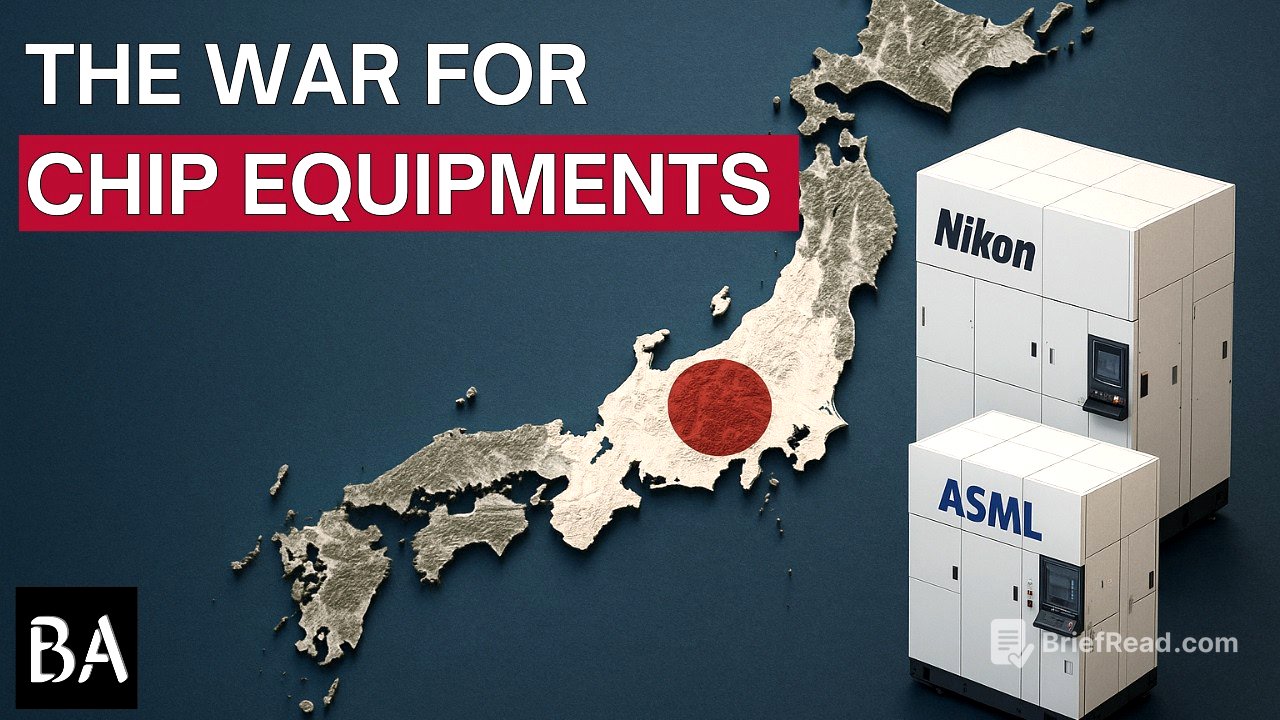TLDR;
This video tells the story of how ASML, a Dutch company, came to dominate the market for photolithography machines, which are essential for manufacturing semiconductors. It contrasts ASML's collaborative, risk-sharing approach with Nikon's more traditional, vertically integrated model, highlighting how Nikon's caution and cultural conservatism led to its downfall. The video also touches on the broader economic and geopolitical factors that played a role in ASML's victory, including the decline of Japan's semiconductor industry and the US government's efforts to promote domestic competition.
- Nikon, once a dominant force in lithography, failed to adapt to new technologies and market dynamics.
- ASML's collaborative approach, involving key customers and suppliers, proved to be a winning strategy.
- The development of EUV lithography was a major turning point, with ASML securing a monopoly on this technology.
- Geopolitical factors, including US export controls, have made ASML a critical chokepoint in the global tech industry.
Nikon's Dominance in the 1980s [1:49]
In the 1980s, Japan's economy was booming, and its semiconductor industry was a global leader. Japanese companies like Hitachi, Toshiba, and NEC operated as vertically integrated conglomerates (keiretsu), controlling every aspect of the chip-making process. Nikon, as a key member of the Mitsubishi keiretsu, benefited from a loyal customer base and close relationships with Japanese chipmakers. The company's expertise in optics, combined with government support, allowed it to dominate the market for steppers, essential machines for projecting chip circuit patterns onto silicon wafers. By the mid-1990s, Nikon and Canon controlled 75% of the lithography market, appearing invincible.
The Emergence of ASML and Step-and-Scan Technology [4:55]
While Nikon focused on perfecting its stepper technology, ASML, a Dutch company spun out of Philips, pioneered a new approach called step-and-scan. This method scanned chip patterns across the wafer, offering advantages such as larger chip designs and improved uniformity. ASML partnered with Carl Zeiss for lens systems, embracing a collaborative model. Their Pass 5500 platform gained traction with major chipmakers outside Japan, including TSMC. Although Nikon developed its own scanner, it remained focused on its established stepper technology, missing the strategic shift in the market.
The Shift to Immersion Lithography [8:32]
As the semiconductor industry approached physical limits in the early 2000s, immersion lithography emerged as a solution. This technique, championed by Burn J. Lin at TSMC, involved placing ultra-pure water between the lens and the silicon wafer to bend light more sharply. ASML embraced immersion technology and partnered with TSMC, securing a crucial early order. Nikon, cautious about the risks of immersion, pursued alternative technologies like Pano, a fatal miscalculation. ASML's Twin Scan platform, with its dual-stage design, proved superior, leading to a market shift. By 2011, ASML controlled 82% of the immersion market, while Nikon's share plummeted.
ASML's Monopoly on EUV Lithography [13:00]
The next major technological leap was extreme ultraviolet (EUV) lithography, which used an even shorter wavelength of light. EUV presented immense technical challenges, including the need for a perfect vacuum and defect-free mirrors. Nikon and Canon abandoned their EUV programs, deeming them unfeasible. ASML persisted but faced astronomical R&D costs. In an unprecedented move, ASML secured investments from Intel, Samsung, and TSMC, who became co-owners and co-funders of the technology. Nikon, lacking the collaborative relationships and financial resources, conceded the leading-edge market. ASML now holds a 100% monopoly on EUV lithography machines.
Factors Behind Nikon's Loss [16:24]
Nikon's defeat was attributed to several factors, including Japan's economic stagnation, which fostered risk aversion. The Japanese semiconductor industry's failure to adapt to the horizontal, fabless foundry model also played a role. Nikon's focus on its domestic market and keiretsu partners may have blinded it to the need for global collaboration. The success of Nikon's camera division may have diverted resources from the riskier lithography business. US government policies may have inadvertently favored ASML by restricting Japanese access to EUV research. Nikon's cultural conservatism, financial constraints, and insular structure ultimately led to its downfall.
ASML's Legacy and Geopolitical Implications [20:06]
ASML's success lies in its collaborative business model, treating suppliers and customers as essential partners. The company's monopoly on EUV lithography has made it a critical geopolitical chokepoint. US export controls aimed at preventing China from acquiring EUV technology have put pressure on ASML and the Dutch government. The future of technological progress depends, in part, on the strategic decisions made by ASML. The lithography wars serve as a reminder that no empire is forever and that collaboration and risk-sharing are essential for success in the relentless march of technology.






![[목돈연구소] 인생 선배, 퇴직한 직장인들이 후회하는 일은 무엇일까? 후회 없는 인생을 위한 길라잡이 I 지식편의점 230702(일)](https://wm-img.halpindev.com/p-briefread_c-10_b-10/urlb/aHR0cDovL2ltZy55b3V0dWJlLmNvbS92aS83YXAtUHdPZlZoYy9ocWRlZmF1bHQuanBn.jpg)


